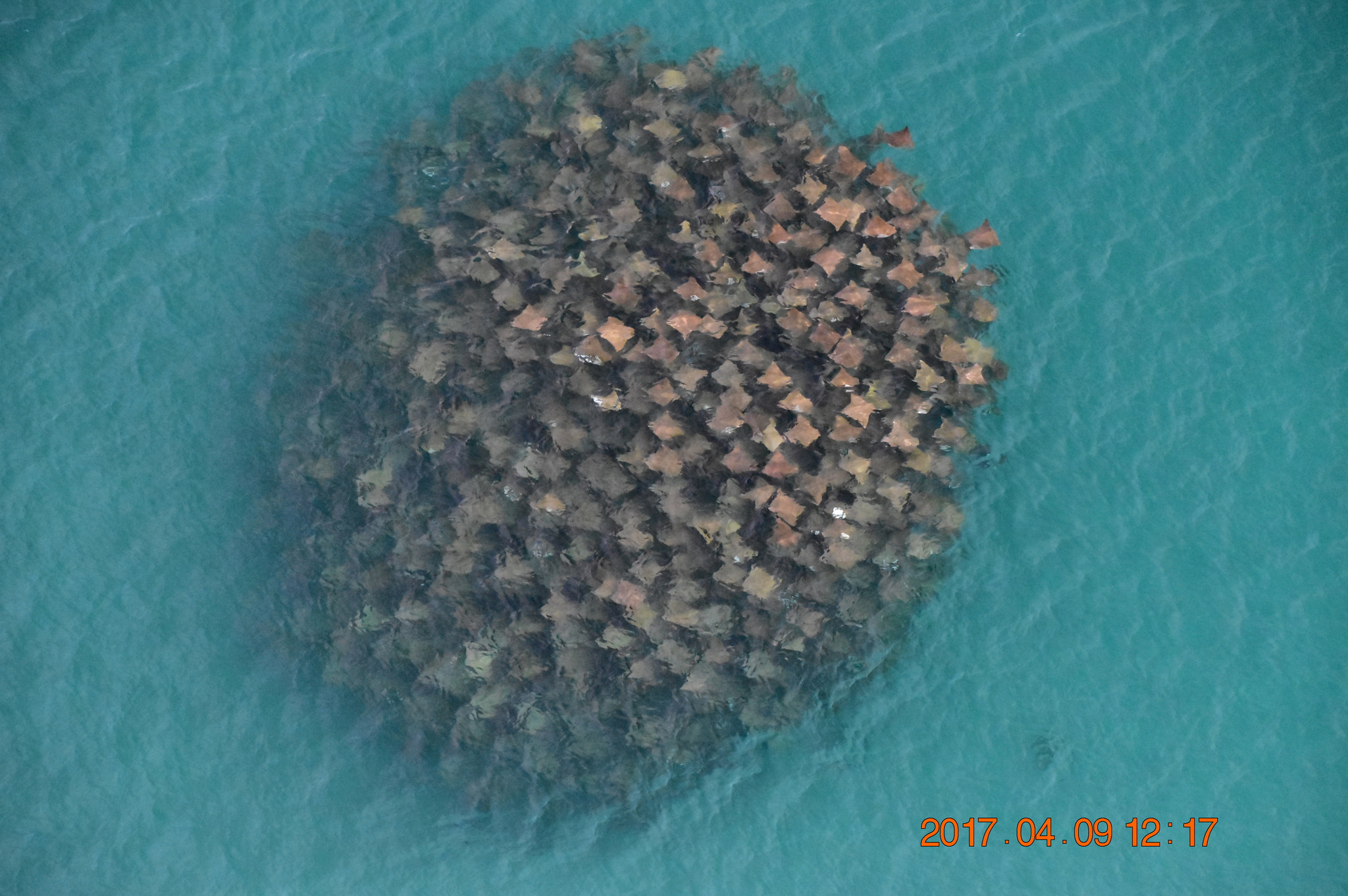Australian Cownose Ray, Rhinoptera neglecta Ogilby 1912
Other Names: Cow Ray, Cow-nose Ray, Cowray, Cow-ray, Flapray, Javanese Cow-ray

A large school of Australian Cownose Rays, Rhinoptera neglecta, off Sussex Inlet, New South Wales, April 2017. Source: stapes070 / iNaturalist.org. License: CC by Attribution-NonCommercial
Summary:
The Australian Cownose Ray is greyish-brown to greyish-green above, uniformly white below, with a single dorsal fin, and a serrated venomous spine near the base of the whip-like tail. Cownose rays have an unusual bi-lobed head, with two large fleshy lobes under the snout.
Video of a huge school of Australian Cownose Rays at the Lighthouse Bommie, Lady Elliot Island, southern Great Barrier Reef, Queensland.
A school of Australian Cownose Rays at Magic Point, Maroubra, New South Wales, June 2016.
Video of a huge school of Australian Cownose Rays at the Lighthouse Bommie, Lady Elliot Island, southern Great Barrier Reef, Queensland.
A school of Australian Cownose Rays at Magic Point, Maroubra, New South Wales, June 2016.
Cite this page as:
Bray, D.J. 2017, Rhinoptera neglecta in Fishes of Australia, accessed 02 Jul 2025, https://fishesofaustralia.net.au/home/species/3547
Australian Cownose Ray, Rhinoptera neglecta Ogilby 1912
More Info
|
Distribution |
Endemic to northern and eastern Australia, from Ashmore Reef, Timor Sea, and the northern Kimberley, Western Australia, to at least Sussex Inlet, New South Wales. The species also occurs in southern Papua New Guinea. Inhabits coastal waters, often forming large schools near the surface. |
|
Size |
Attains a maximum size of at least 130 cm DW (disc width). Pups are born at ~31 cm DW. |
|
Feeding |
Thought to feed mostly on small fishes, cephalopod molluscs and other invertebrates. |
|
Biology |
Reproduction is aplacental viviparous. Sometimes netted on tidal mudflats of northern Queensland. |
|
Fisheries |
Taken as bycatch in commercial prawn trawl fisheries in parts of its range. |
|
Species Citation |
Rhinoptera neglecta Ogilby, 1912, Mem. Qld Mus. 1: 32. Type locality: Moreton Bay, QLD. |
|
Author |
Bray, D.J. 2017 |
|
Resources |
Australian Cownose Ray, Rhinoptera neglecta Ogilby 1912
References
Compagno, L.J.V. & Last, P.R. 1999. Families Gymnuridae, Myliobatidae, Rhinopteridae, Mobulidae. pp. 1505-1529 in Carpenter, K.E. & Niem, V.H. (eds) The Living Marine Resources of the Western Central Pacific. FAO Species Identification Guide for Fisheries Purposes. Rome : FAO Vol. 3 pp. 1397-2068.
De Vis, C.W. 1885. An example of the ray, Rhinoptera javanica, M. & H., from Moreton Bay. Proceedings of the Royal Society of Queensland 2(1): 12. (misidentification)
Daley, R.K., Stevens, J.D., Last, P.R. & Yearsley, G.K. 2002. Field Guide to Australian Sharks & Rays. Hobart : CSIRO Marine Research 84 pp.
Dulvy, N.K. & J.D. Reynolds. 1997. Evolutionary transitions among egg-laying, live-bearing and maternal inputs in sharks and rays. Proceedings of the Royal Society of London, Ser. B: Biol. Sci. 264: 1309-1315.
Grant, E.M. 1975. Guide to Fishes. Brisbane : Queensland Government, Co-ordinator General’s Department 640 pp.
Jacobsen, I.P. & Stevens, J. 2015. Rhinoptera neglecta. The IUCN Red List of Threatened Species 2015: e.T161530A68642171. http://dx.doi.org/10.2305/IUCN.UK.2015-4.RLTS.T161530A68642171.en. Downloaded on 18 November 2017.
Johnson, J.W. 2010. Fishes of the Moreton Bay Marine Park and adjacent continental shelf waters, Queensland, Australia. pp. 299-353 in Davie, P.J.F. & Phillips, J.A. Proceedings of the Thirteenth International Marine Biological Workshop, The Marine Fauna and Flora of Moreton Bay. Memoirs of the Queensland Museum 54(3)
Last, P.R. & Stevens, J.D. 1994. Sharks and Rays of Australia. Canberra : CSIRO Australia 513 pp. 84 pls.
Last, P.R. & Stevens, J.D. 2009. Sharks and Rays of Australia. Collingwood : CSIRO Publishing Australia 2, 550 pp.
Stead, D.G. 1963. Sharks and Rays of Australian Seas. Sydney : Angus & Robertson 211 pp. 63 figs.
Whitley, G.P. 1940. The Fishes of Australia. Part 1. The sharks, rays, devil-fish, and other primitive fishes of Australia and New Zealand. Sydney : Roy. Zool. Soc. N.S.W. 280 pp. 303 figs.


